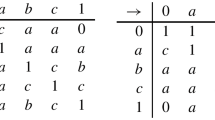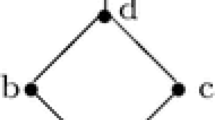Abstract
Lattice theory has close connections with modal logic via algebraic semantics and lattices of modal logics. However, one less explored direction is to view lattices as relational structures based on partial orders, and study the modal logic over them. In this paper, following the earlier steps of Burgess and van Benthem in the 1980s, we use the basic tense logic and its nominal extensions with binary modalities of infimum and supremum to talk about lattices via standard Kripke semantics. As the main results, we obtain a series of complete axiomatizations of lattices, (un)bounded lattices over partial orders or strict preorders. In particular, we solve an axiomatization problem left open by Burgess (1984).
Access this chapter
Tax calculation will be finalised at checkout
Purchases are for personal use only
Similar content being viewed by others
Notes
- 1.
Burgess calls the strict order satisfying \(\texttt{FOASym}\) and \(\texttt{FOSTrans}\) partial order.
- 2.
Here “unbounded” means there are no greatest and least elements.
- 3.
Note that the canonicity is based on the canonical model of normal tense logics.
- 4.
E.g., by Proposition 1 (2), a frame validating \(\mathtt {CR_\textsf {G}}\) also has the property \(\forall x\forall y (xRy \rightarrow \exists t(yRt))\) (obtained by taking \(y=z\) in the original corresponding first-order property).
- 5.
Two formulas \(\textsf {F}p \wedge \textsf {F}q \rightarrow \textsf {F}(\textsf {P}p \wedge \textsf {P}q)\), \(\textsf {P}p \wedge \textsf {P}q \rightarrow \textsf {P}(\textsf {F}p \wedge \textsf {F}q)\) are mentioned in [10] as alternatives for \(\mathtt {CR_\textsf {G}}\) and \(\mathtt {CR_\textsf {H}}\), but they are also not valid over \(\mathfrak {L}_{<}\).
- 6.
This condition is to break the potential symmetry and reflexivity in \(\mathcal {M}^c_\mathbb{S}\mathbb{L}\).
- 7.
Note that this can indeed happen, e.g., when \(\textsf {G}\bot \wedge \textsf {H}\bot \in \varSigma _0\) thus no \(\textsf {F}\varphi \) or \(\textsf {P}\varphi \) is in \(\varSigma _0\).
References
van Benthem, J.: Semantic parallels in natural language and computation. In: Studies in Logic and the Foundations of Mathematics, vol. 129 (1989)
van Benthem, J.: Modal logic as a theory of information. In: Copeland, J. (ed.) Logic and Reality: Essays on the legacy of Arthur Prior, pp. 135–158. Clarendon Press, Oxford (1996)
van Benthem, J.: Implicit and explicit stances in logic. J. Philos. Log. 48(3), 571–601 (2019)
Birkhoff, G., Neumann, J.V.: The Logic of Quantum Mechanics. Springer, Dordrecht (1975)
Birkhoff, G.T.: Lattice Theory. American Mathematical Society (1967)
Blackburn, P., de Rijke, M., Venema, Y.: Modal Logic. Cambridge University Press, Cambridge (2001)
Blackburn, P.: Nominal tense logic. Notre Dame J. Formal Logic 34(1), 56–83 (1993)
Blok, W.J.: The lattice of modal logics: an algebraic investigation. J. Symb. Log. 45(2), 221–236 (1980)
Boole, G.: The mathematical analysis of logic. Bull. Math. Biophys. 12(5), 107–107 (2009)
Burgess, J.P.: Basic tense logic. In: Gabbay, D., Guenthner, F. (eds.) Handbook of Philosophical Logic: Volume II: Extensions of Classical Logic, pp. 89–133. Springer, Dordrecht (1984). https://doi.org/10.1007/978-94-009-6259-0_2
Fine, K.: Truth-maker semantics for intuitionistic logic. J. Philos. Log. 43(2–3), 549–577 (2014)
Gargov, G., Goranko, V.: Modal logic with names. J. Philos. Log. 22(6), 607–636 (1993)
Goldblatt, R., Hodkinson, I.: The McKinsey-Lemmon logic is barely canonical. Australas. J. Logic 5 (2007)
Hamkins, J.D., Kikuchi, M.: Set-theoretic mereology. Logic Logical Philos. Special issue “Mereology and beyond, Part II” 25(3), 285–308 (2016)
Holliday, W.H.: On the modal logic of subset and superset: tense logic over Medvedev frames. Stud. Logica. 105(1), 13–35 (2017)
Li, D., Wang, Y.: Mereological bimodal logics. Rev. Symb. Logic 1–36 (2022). https://doi.org/10.1017/S175502032200003X
Medvedev, Y.T.: Degrees of difficulty of the mass problems. Dokl. Akad. Nauk SSSR 104, 501–504 (1955)
Prior, A.: Time and Modality. Oxford University Press, Clarendon Press (1957)
Rose, A.: Systems of logic whose truth-values form lattices. Math. Ann. 123, 152–165 (1951)
Sadrzadeh, M., Dyckhoff, R.: Positive logic with adjoint modalities: proof theory, semantics, and reasoning about information. Rev. Symb. Logic 3(3), 351–373 (2010)
Acknowledgement
The authors thank John Burgess, Johan van Benthem, and the two anonymous reviewers of WoLLIC2022 for relevant pointers and suggestions. The research is supported by NSSF grant 19BZX135.
Author information
Authors and Affiliations
Corresponding author
Editor information
Editors and Affiliations
Rights and permissions
Copyright information
© 2022 The Author(s), under exclusive license to Springer Nature Switzerland AG
About this paper
Cite this paper
Wang, X., Wang, Y. (2022). Tense Logics over Lattices. In: Ciabattoni, A., Pimentel, E., de Queiroz, R.J.G.B. (eds) Logic, Language, Information, and Computation. WoLLIC 2022. Lecture Notes in Computer Science, vol 13468. Springer, Cham. https://doi.org/10.1007/978-3-031-15298-6_5
Download citation
DOI: https://doi.org/10.1007/978-3-031-15298-6_5
Published:
Publisher Name: Springer, Cham
Print ISBN: 978-3-031-15297-9
Online ISBN: 978-3-031-15298-6
eBook Packages: Computer ScienceComputer Science (R0)





